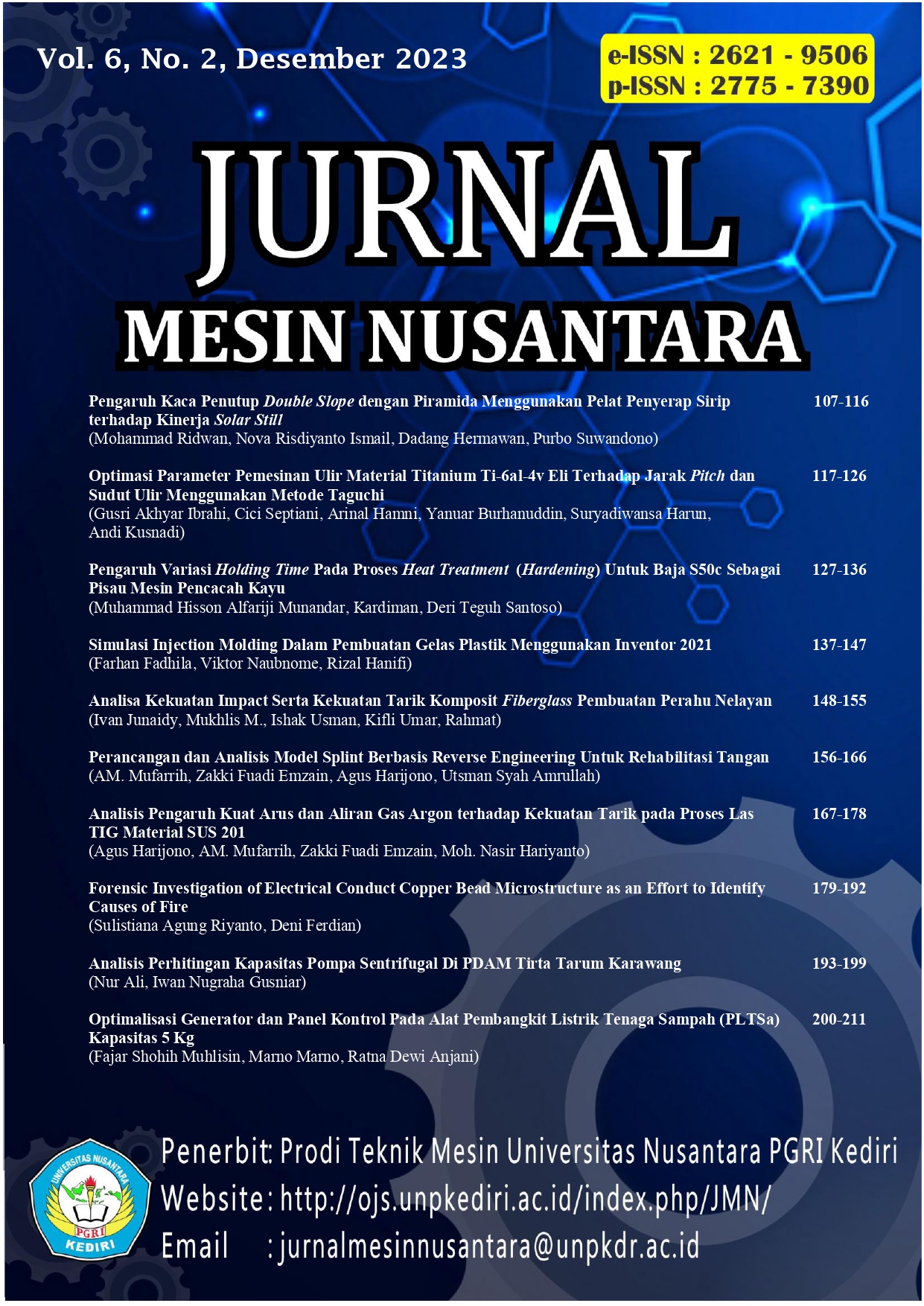Perancangan dan Analisis Model Splint Berbasis Reverse Engineering Untuk Rehabilitasi Tangan
DOI:
https://doi.org/10.29407/jmn.v6i2.21327Keywords:
finite element analysis, rapid prototyping, reverse engineering, splint tanganAbstract
Pertolongan pertama cedera lengan akibat kecelakaan, imobilisasi harus dilakukan untuk mengurangi pergerakan yang menyebabkan rasa nyeri pada bagian lengan yang cedera, melindungi lengan dari benturan, dan membantu proses penyembuhannya. Imobilisasi biasanya dilakukan dengan pembidaian atau splint. Saat ini, papan kayu yang digunakan sebagai pembidaian menjaga posisi anggota tubuh yang cedera. Namun, bentuk papan kayu tidak mengikuti bentuk tubuh pasien, yang membuatnya kurang nyaman dan memakan waktu lebih lama untuk dipasang. Studi ini mendesain dan menganalisis model splint yang digunakan untuk rehabilitasi cedera tangan. Untuk membuat splint tangan ini lebih sesuai dengan bentuk dan nyaman digunakan, mereka dirancang dengan memperhatikan variasi ukuran dan bentuk anatomi pasien. Teknologi reverse engineering (RE) dan rapid prototyping (RP) dapat digunakan dalam bidang medis, seperti membuat alat orthosis atau splint. Metode penelitian ini dimulai dengan membaca literatur, menggambar 3D, membuat model CAD, menganalisis model, mencetak 3D, dan pasca-proses. Untuk model ini, material ABS dengan ketebalan 5 mm, 6 mm, dan 7 mm serta nilai pembebanan 5 N hingga 25 N digunakan. Hasil analisis tekanan equivalent menunjukkan bahwa model ketebalan 5 mm mampu menahan tekanan 25 N dengan tekanan maksimum equivalent sebesar 13.52 MPa, yang masih dianggap aman dengan nilai safety factor 2.11, dan area penting di ujung punggung telapak tangan model antara ibu jari dan jari telunjuk.
Downloads
References
H. Hsu, M. P. Fahrenkopf, and S. V Nallamothu, “Wrist fracture,” StatPearls [Internet], 2021.
M. S. Sirajudeen, M. Alaidarous, M. Waly, and M. Alqahtani, “Work-related musculoskeletal disorders among faculty members of college of Applied Medical Sciences, Majmaah University, Saudi Arabia: A cross-sectional study,” Int. J. Health Sci. (Qassim)., vol. 12, no. 4, p. 18, 2018.
M. Calbiyik, “Fixation of unstable distal radius fractures by using expandable Intramedullary nailing system in adult patients,” Pakistan J. Med. Sci., vol. 34, no. 1, p. 198, 2018.
Y. K. Modi, “Calcium sulphate based 3D printed tooling for vacuum forming of medical devices: an experimental evaluation,” Mater. Technol., vol. 33, no. 10, pp. 642–650, 2018.
J. L. Keller, J. P. Henderson, K. W. Landrieu, M. P. Dimick, and J. M. Walsh, “The 2019 practice analysis of hand therapy and the use of orthoses by certified hand therapists,” J. Hand Ther., 2021.
D. Palousek, J. Rosicky, D. Koutny, P. Stoklásek, and T. Navrat, “Pilot study of the wrist orthosis design process,” Rapid Prototyp. J., 2014.
H. Dodziuk, “Applications of 3D printing in healthcare,” Kardiochirurgia i torakochirurgia Pol. Polish J. cardio-thoracic Surg., vol. 13, no. 3, p. 283, 2016.
K. J. Young, J. E. Pierce, and J. M. Zuniga, “Assessment of body-powered 3D printed partial finger prostheses: a case study,” 3D Print. Med., vol. 5, no. 1, pp. 1–8, 2019.
H. Choi, A. Seo, and J. Lee, “Mallet Finger Lattice Casts Using 3D Printing,” J. Healthc. Eng., vol. 2019, 2019.
Z. F. Emzain, U. S. Amrullah, and A. M. Mufarrih, “Analisis elemen hingga untuk siklus berjalan pada model prostetik lentur pergelangan kaki,” J. POLIMESIN, vol. 18, no. 2, pp. 91–98, 2020.
Z. F. Emzain, U. S. Amrullah, A. Mufarrih, N. Qosim, and Y. D. Herlambang, “Design optimization of sleeve finger splint model using Finite Element Analysis,” J. Polimesin, vol. 19, no. 2, pp. 147–152, 2021.
Downloads
Published
Issue
Section
License
Authors who publish with this journal agree to the following terms:
- Copyright on any article is retained by the author(s).
- The author grants the journal, right of first publication with the work simultaneously licensed under a Creative Commons Attribution License that allows others to share the work with an acknowledgment of the work’s authorship and initial publication in this journal.
- Authors are able to enter into separate, additional contractual arrangements for the non-exclusive distribution of the journal’s published version of the work (e.g., post it to an institutional repository or publish it in a book), with an acknowledgment of its initial publication in this journal.
- Authors are permitted and encouraged to post their work online (e.g., in institutional repositories or on their website) prior to and during the submission process, as it can lead to productive exchanges, as well as earlier and greater citation of published work.
- The article and any associated published material is distributed under the Creative Commons Attribution-ShareAlike 4.0 International License












